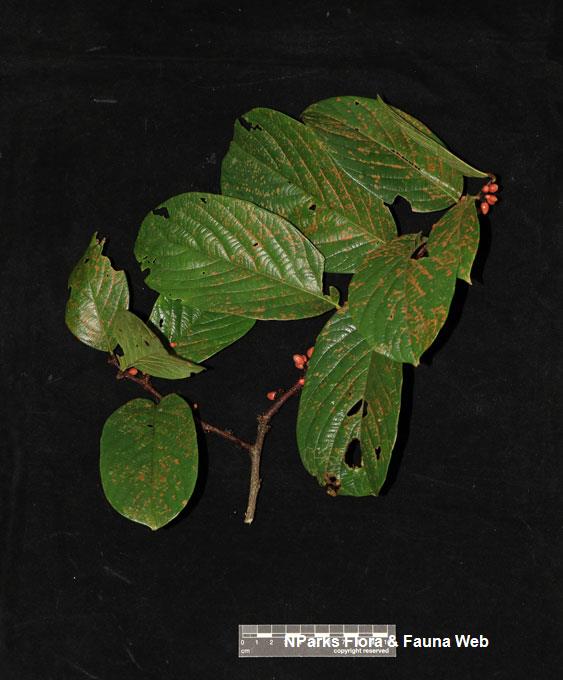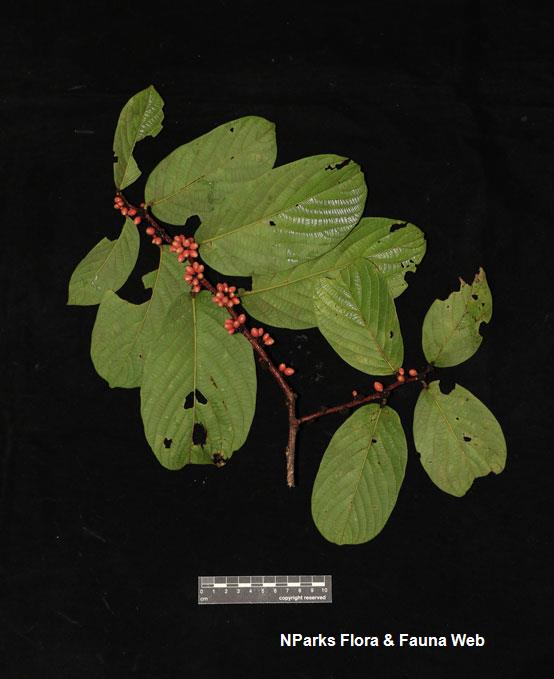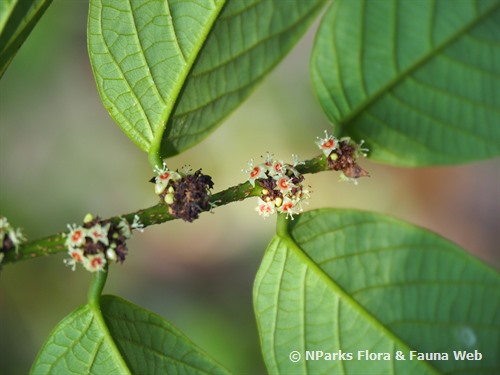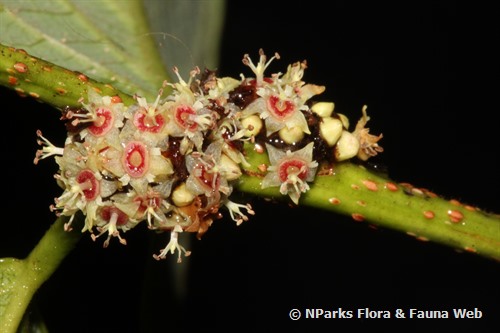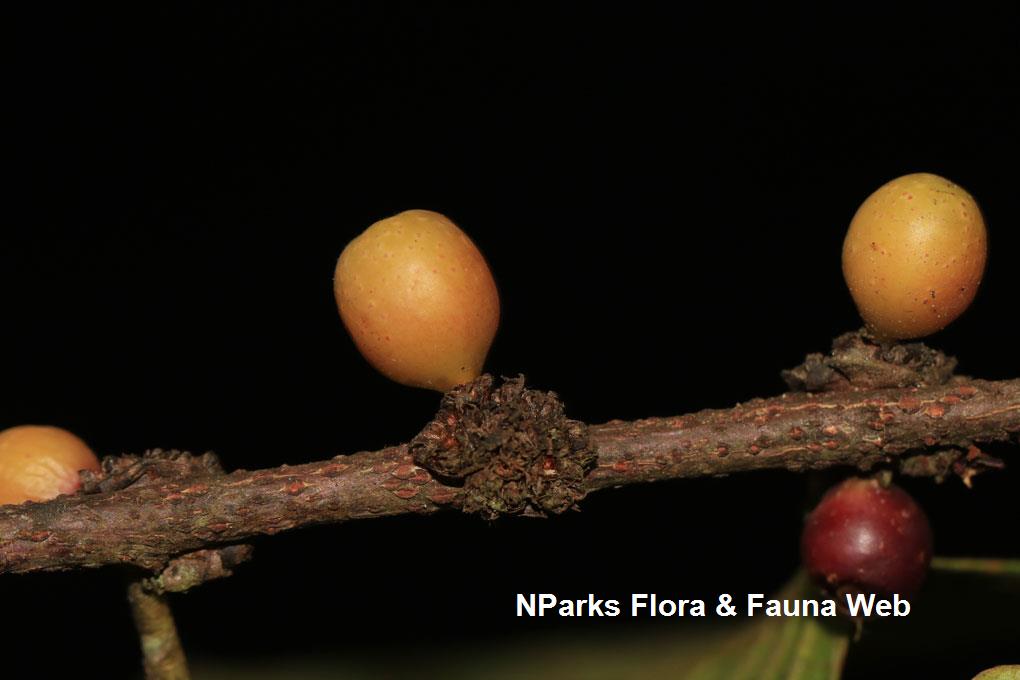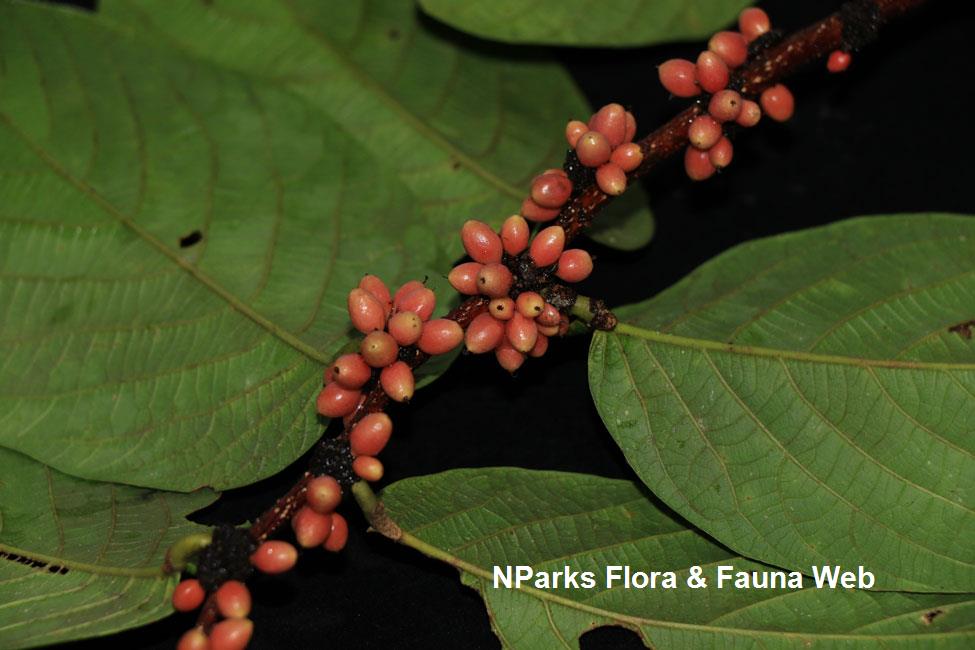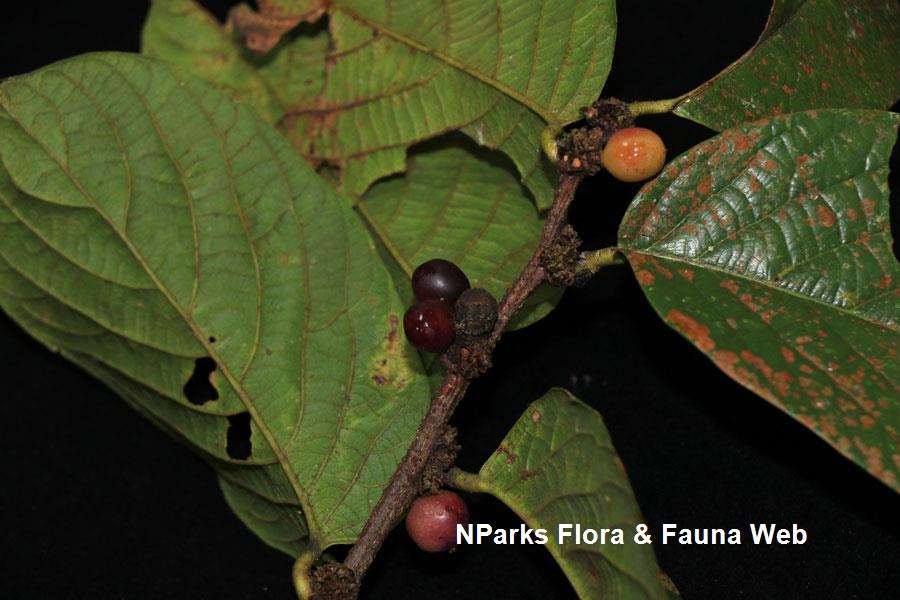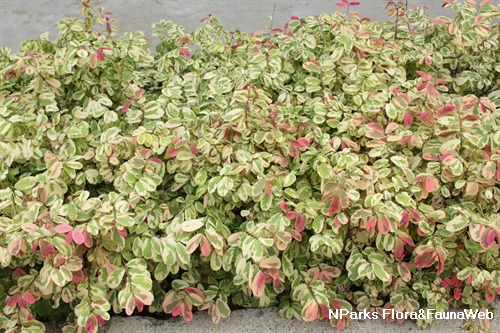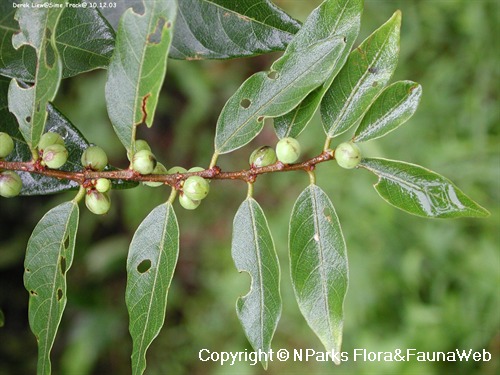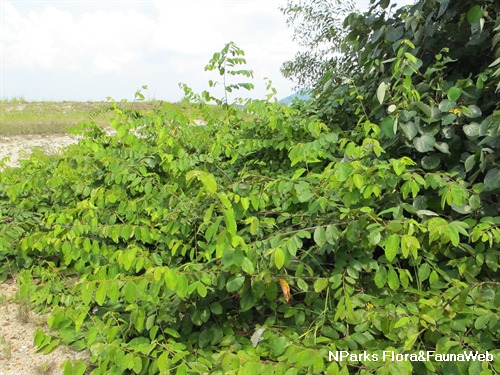
Back
Bridelia pustulata Hook.f.
| Family Name: | Phyllanthaceae |
| Common Name: | Bubongkal, Kenidei Hutan |
Bridelia pustulata or Bubongkal is a tree native to Singapore. Growing to 20 m tall, it has leathery, elliptic to elongated leaves with brown hairs on the underside. Flowers are monoecious, brownish-red to pink, densely clustered into a cushion-like inflorescence made up of 5 small, elliptic petals, 5 long, narrow, triangular sepals and a red disc-center. The fruit is a single-seeded, elliptic to egg-shaped drupe which ripens from green to red then purple-black or bluish black held in a cluster of up to 10.
Name
Classifications and Characteristics
| Plant Division | Angiosperms (Flowering Seed Plants) (Dicotyledon) |
|---|---|
| Plant Growth Form | Tree (Medium (16m-30m)) |
| Lifespan (in Singapore) | Perennial |
| Mode of Nutrition | Autotrophic |
| Maximum Height | 20 m |
Biogeography
| Native Distribution | Peninsular Malaysia, Sumatra, Borneo, Philippines, Singapore |
|---|---|
| Native Habitat | Terrestrial (Primary Rainforest, Freshwater Swamp Forest) |
| Preferred Climate Zone | Tropical |
| Local Conservation Status | Native to Singapore (Critically Endangered (CR)) |
Description and Ethnobotany
| Growth Form | It is a medium-sized tree that reaches to 20 m tall. It has clear straight trunk, dense crown, stilt roots and sharp thorns might be present at the base. |
|---|---|
| Foliage | Leaves are elliptic to elongated, sometimes slightly spoon to egg-shaped, leathery but papery when young, measuring 9 - 23 cm long by 3 - 11.5 cm wide. The veins are darker above, prominent on the underside, bending up towards the margin joining into the next veinlet. Brown hairs are found on the underside while the top remains smooth with no hairs. |
| Flowers | Flowers are monoecious, where the male and female flowers are produced on the same individual. Brownish-red to pink flowers cluster to form a dense, cushion-like inflorescence found along the axils. Each flower is 3 - 4 mm wide, with 5 petals and sepals and a red disc-like center. The petals are small, elliptic, irregularly lobed at the tip while sepals are long, narrow, triangular. |
| Fruit | The fruit is a single-seeded, elliptic to egg-shaped drupe measuring 7 - 8 mm long, 5 - 7 mm wide held on a cluster of up to 10 fruits. Fruit may be stalked of up to 1.5 mm in length, ripening from green to red then purple-black or bluish black. |
| Habitat | Occurs in primary forest, from sea level up to 350 m altitude. <1> |
| Etymology | Bridelia, commemorating Professor S. E. Bridel (1761-1828); Latin pustulata, pimpled in reference to the texture of the branches and twigs. |
| Ethnobotanical Uses | Timber & Products: Its timber have been used by the rural communities as posts for houses due to its durability. |
Plant Care and Propagation
| Light Preference | Full Sun |
|---|---|
| Water Preference | Moderate Water |
| Plant Growth Rate | Moderate |
| Rootzone Tolerance | Fertile Loamy Soils, Moist Soils, Well-Drained Soils |
| Propagation Method | Seed |
Foliar
| Foliage Retention | Evergreen |
|---|---|
| Mature Foliage Colour(s) | Green |
| Foliar Type | Simple / Unifoliate |
| Foliar Arrangement Along Stem | Alternate |
| Foliar Attachment to Stem | Petiolate |
| Foliar Shape(s) | Non-Palm Foliage (Elliptical, Oblong, Obovate, Ovate) |
| Foliar Venation | Pinnate / Net |
| Foliar Margin | Entire |
| Foliar Apex - Tip | Acuminate, Acute, Obtuse |
| Foliar Base | Acute, Rounded / Obtuse |
Non - Foliar and Storage
| Mature Bark Texture | Armed / Thorny |
|---|---|
| Stem Type & Modification | Woody |
| Root Type | Underground |
Floral (Angiosperm)
| Flower & Plant Sexuality | Unisexual Flowers , Monoecious |
| Flower Colour(s) | White, Red |
|---|
| Flower Grouping | Cluster / Inflorescence |
| Flower Location | Axillary |
Fruit, Seed and Spore
| Mature Fruit Colour(s) | Purple, Black |
|---|---|
| Fruit Classification | Simple Fruit |
| Fruit Type | Fleshy Fruit , Drupe |
| Seed Quantity Per Fruit | Few (1-5) |
References
| References | <1> Dressler, S. (1996). The genus Bridelia (Euphorbiacaeae) in Malesia and Indochina: A regional revision. Blumea 41: 320 - 322. |
|---|
Image Repository
Others
| Master ID | 31591 |
|---|---|
| Species ID | 5990 |
| Flora Disclaimer | The information in this website has been compiled from reliable sources, such as reference works on medicinal plants. It is not a substitute for medical advice or treatment and NParks does not purport to provide any medical advice. Readers should always consult his/her physician before using or consuming a plant for medicinal purposes. |

